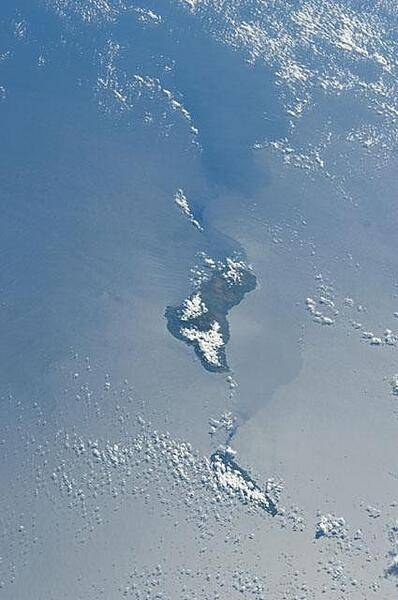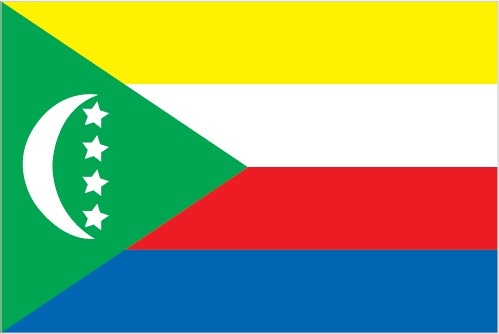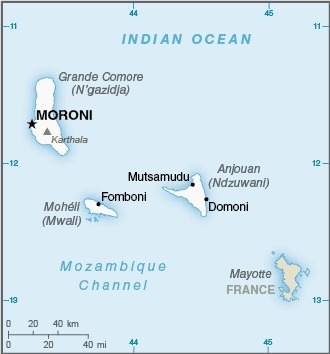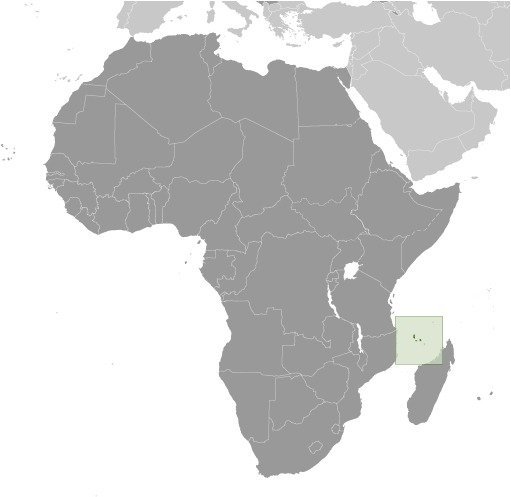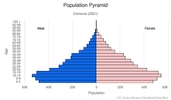Comoros
Introduction
Background
The archipelago of the Comoros in the Indian Ocean, composed of the islands of Mayotte, Anjouan, Moheli, and Grande Comore declared independence from France on 6 July 1975. Residents of Mayotte voted to remain in France, and France now has classified it as a department of France. Since independence, Comoros has endured political instability through realized and attempted coups. In 1997, the islands of Anjouan and Moheli declared independence from Comoros. In 1999, military chief Col. AZALI Assoumani seized power of the entire government in a bloodless coup; he initiated the 2000 Fomboni Accords, a power-sharing agreement in which the federal presidency rotates among the three islands, and each island maintains its local government. AZALI won the 2002 federal presidential election as president of the Union of the Comoros from Grande Comore Island, which held the first four-year term. AZALI stepped down in 2006 and President Ahmed Abdallah Mohamed SAMBI was elected to office as president from Anjouan. In 2007, Mohamed BACAR effected Anjouan's de-facto secession from the Union of the Comoros, refusing to step down when Comoros' other islands held legitimate elections in July. The African Union (AU) initially attempted to resolve the political crisis by applying sanctions and a naval blockade to Anjouan, but in March 2008 the AU and Comoran soldiers seized the island. The island's inhabitants generally welcomed the move. In 2009, the Comorian population approved a constitutional referendum extending the term of the president from four years to five years. In May 2011, Ikililou DHOININE won the presidency in peaceful elections widely deemed to be free and fair. In closely contested elections in 2016, former President AZALI Assoumani won a second term, when the rotating presidency returned to Grande Comore. A new July 2018 constitution removed the presidential term limits and the requirement for the presidency to rotate between the three main islands. In August 2018, President AZALI formed a new government and subsequently ran and was elected president in March 2019.
Visit the Definitions and Notes page to view a description of each topic.
Geography
Location
Southern Africa, group of islands at the northern mouth of the Mozambique Channel, about two-thirds of the way between northern Madagascar and northern Mozambique
Geographic coordinates
12 10 S, 44 15 E
Map references
Africa
Land boundaries
total: 0 km
Coastline
340 km
Maritime claims
territorial sea: 12 nm
exclusive economic zone: 200 nm
Climate
tropical marine; rainy season (November to May)
Terrain
volcanic islands, interiors vary from steep mountains to low hills
Elevation
highest point: Karthala 2,360 m
lowest point: Indian Ocean 0 m
Land use
agricultural land: 84.4% (2018 est.)
arable land: 46.7% (2018 est.)
permanent crops: 29.6% (2018 est.)
permanent pasture: 8.1% (2018 est.)
forest: 1.4% (2018 est.)
other: 14.2% (2018 est.)
Irrigated land
1.3 sq km (2012)
Population distribution
the capital city of Maroni, located on the western side of the island of Grande Comore, is the country's largest city; however, of the three islands that comprise Comoros, it is Anjouan that is the most densely populated as shown in this population distribution map
Natural hazards
cyclones possible during rainy season (December to April); volcanic activity on Grand Comore
volcanism: Karthala (2,361 m) on Grand Comore Island last erupted in 2007; a 2005 eruption forced thousands of people to be evacuated and produced a large ash cloud
Geography - note
important location at northern end of Mozambique Channel
People and Society
Nationality
noun: Comoran(s)
adjective: Comoran
Ethnic groups
Antalote, Cafre, Makoa, Oimatsaha, Sakalava
Languages
Arabic (official), French (official), Shikomoro (official; a blend of Swahili and Arabic) (Comorian)
Religions
Sunni Muslim 98%, other (including Shia Muslim, Roman Catholic, Jehovah's Witness, Protestant) 2%
note: Sunni Islam is the state religion
Demographic profile
Comoros’ population is a melange of Arabs, Persians, Indonesians, Africans, and Indians, and the much smaller number of Europeans that settled on the islands between the 8th and 19th centuries, when they served as a regional trade hub. The Arab and Persian influence is most evident in the islands’ overwhelmingly Muslim majority – about 98% of Comorans are Sunni Muslims. The country is densely populated, averaging nearly 350 people per square mile, although this varies widely among the islands, with Anjouan being the most densely populated.
Given the large share of land dedicated to agriculture and Comoros’ growing population, habitable land is becoming increasingly crowded. The combination of increasing population pressure on limited land and resources, widespread poverty, and poor job prospects motivates thousands of Comorans each year to attempt to illegally migrate using small fishing boats to the neighboring island of Mayotte, which is a French territory. The majority of legal Comoran migration to France came after Comoros’ independence from France in 1975, with the flow peaking in the mid-1980s.
At least 150,000 to 200,000 people of Comoran citizenship or descent live abroad, mainly in France, where they have gone seeking a better quality of life, job opportunities, higher education (Comoros has no universities), advanced health care, and to finance elaborate traditional wedding ceremonies (aada). Remittances from the diaspora are an economic mainstay, in 2013 representing approximately 25% of Comoros’ GDP and significantly more than the value of its exports of goods and services (only 15% of GDP). Grand Comore, Comoros’ most populous island, is both the primary source of emigrants and the main recipient of remittances. Most remittances are spent on private consumption, but this often goes toward luxury goods and the aada and does not contribute to economic development or poverty reduction. Although the majority of the diaspora is now French-born with more distant ties to Comoros, it is unclear whether they will sustain the current level of remittances.
Age structure
0-14 years: 36.68% (male 154,853/female 155,602)
15-24 years: 20.75% (male 85,208/female 90,422)
25-54 years: 33.99% (male 136,484/female 151,178)
55-64 years: 4.49% (male 17,237/female 20,781)
65 years and over: 4.08% (male 15,437/female 19,079) (2020 est.)
Dependency ratios
total dependency ratio: 75.5
youth dependency ratio: 67.4
elderly dependency ratio: 5.4
potential support ratio: 18.6 (2020 est.)
Median age
total: 20.9 years
male: 20.2 years
female: 21.5 years (2020 est.)
Population distribution
the capital city of Maroni, located on the western side of the island of Grande Comore, is the country's largest city; however, of the three islands that comprise Comoros, it is Anjouan that is the most densely populated as shown in this population distribution map
Urbanization
urban population: 29.6% of total population (2021)
rate of urbanization: 2.97% annual rate of change (2020-25 est.)
Major urban areas - population
62,000 MORONI (capital) (2018)
Sex ratio
at birth: 1.03 male(s)/female
0-14 years: 1 male(s)/female
15-24 years: 0.94 male(s)/female
25-54 years: 0.9 male(s)/female
55-64 years: 0.83 male(s)/female
65 years and over: 0.81 male(s)/female
total population: 0.94 male(s)/female (2020 est.)
Mother's mean age at first birth
23 years (2012 est.)
note: median age at first birth among women 25-49
Maternal mortality ratio
273 deaths/100,000 live births (2017 est.)
country comparison to the world: 40Infant mortality rate
total: 58.21 deaths/1,000 live births
male: 68.34 deaths/1,000 live births
female: 47.78 deaths/1,000 live births (2021 est.)
Life expectancy at birth
total population: 66.9 years
male: 64.65 years
female: 69.21 years (2021 est.)
Contraceptive prevalence rate
19.4% (2012)
Drinking water source
improved: urban: 97.4% of population
rural: 88.5% of population
total: 91% of population
unimproved: urban: 2.6% of population
rural: 11.5% of population
total: 8.9% of population (2017 est.)
Current Health Expenditure
4.6% (2018)
Physicians density
0.27 physicians/1,000 population (2016)
Hospital bed density
2.2 beds/1,000 population (2010)
Sanitation facility access
improved: urban: 62.4% of population
rural: 43.6% of population
total: 49% of population
unimproved: urban: 37.6% of population
rural: 56.4% of population
total: 51% of population (2017 est.)
HIV/AIDS - adult prevalence rate
<.1% (2020 est.)
HIV/AIDS - people living with HIV/AIDS
<200 (2020 est.)
HIV/AIDS - deaths
<100 (2020 est.)
Literacy
definition: age 15 and over can read and write
total population: 58.8%
male: 64.6%
female: 53% (2018)
School life expectancy (primary to tertiary education)
total: 11 years
male: 11 years
female: 11 years (2014)
Unemployment, youth ages 15-24
total: 19.5%
male: 20%
female: 18.8% (2014)
Environment
Environment - current issues
deforestation; soil degradation and erosion results from forest loss and from crop cultivation on slopes without proper terracing; marine biodiversity affected as soil erosion leads to the silting of coral reefs
Environment - international agreements
party to: Biodiversity, Climate Change, Climate Change-Kyoto Protocol, Climate Change-Paris Agreement, Comprehensive Nuclear Test Ban, Desertification, Endangered Species, Hazardous Wastes, Law of the Sea, Ozone Layer Protection, Ship Pollution, Wetlands
signed, but not ratified: none of the selected agreements
Air pollutants
particulate matter emissions: 18.6 micrograms per cubic meter (2016 est.)
carbon dioxide emissions: 0.2 megatons (2016 est.)
methane emissions: 0.19 megatons (2020 est.)
Climate
tropical marine; rainy season (November to May)
Land use
agricultural land: 84.4% (2018 est.)
arable land: 46.7% (2018 est.)
permanent crops: 29.6% (2018 est.)
permanent pasture: 8.1% (2018 est.)
forest: 1.4% (2018 est.)
other: 14.2% (2018 est.)
Urbanization
urban population: 29.6% of total population (2021)
rate of urbanization: 2.97% annual rate of change (2020-25 est.)
Revenue from forest resources
forest revenues: 1.39% of GDP (2018 est.)
country comparison to the world: 46Waste and recycling
municipal solid waste generated annually: 91,013 tons (2015 est.)
Total water withdrawal
municipal: 4.8 million cubic meters (2017 est.)
industrial: 500,000 cubic meters (2017 est.)
agricultural: 4.7 million cubic meters (2017 est.)
Total renewable water resources
1.2 billion cubic meters (2017 est.)
Government
Country name
conventional long form: Union of the Comoros
conventional short form: Comoros
local long form: Udzima wa Komori (Comorian), Union des Comores (French), Jumhuriyat al Qamar al Muttahidah (Arabic)
local short form: Komori (Comorian), Comores (French), Juzur al Qamar (Arabic)
etymology: name derives from the Arabic designation "Juzur al Qamar" meaning "Islands of the Moon"
Government type
federal presidential republic
Capital
name: Moroni
geographic coordinates: 11 42 S, 43 14 E
time difference: UTC+3 (8 hours ahead of Washington, DC, during Standard Time)
etymology: Moroni derives from "mroni," which means "at the river" in Shingazidja, the Comorian language spoken on Grande Comore (N'gazidja)
Administrative divisions
3 islands; Anjouan (Ndzuwani), Grande Comore (N'gazidja), Moheli (Mwali)
Independence
6 July 1975 (from France)
National holiday
Independence Day, 6 July (1975)
Constitution
history: previous 1996, 2001; newest adopted 30 July 2018
amendments: proposed by the president of the union or supported by at least one third of the Assembly of the Union membership; adoption requires approval by at three-quarters majority of the total Assembly membership or approval in a referendum
note: a referendum held on 30 July 2018 - boycotted by the opposition - overwhelmingly approved a new constitution that allows for 2 consecutive 5-year presidential terms and revises the rotating presidency within the islands
Legal system
mixed legal system of Islamic religious law, the French civil code of 1975, and customary law
International law organization participation
has not submitted an ICJ jurisdiction declaration; accepts ICCt jurisdiction
Citizenship
citizenship by birth: no
citizenship by descent only: at least one parent must be a citizen of the Comoros
dual citizenship recognized: no
residency requirement for naturalization: 10 years
Suffrage
18 years of age; universal
Executive branch
chief of state: President AZALI Assoumani (since 26 May 2016); note - the president is both chief of state and head of government; note - AZALI takes oath of office 2 June 2019 after 24 March 2019 reelection (2019)
head of government: President AZALI Assoumani (since 26 May 2016)
cabinet: Council of Ministers appointed by the president
elections/appointments: president directly elected by simple majority popular vote in 2 rounds for a 5-year term (eligible for a second term); election last held on 24 March 2019 (next to be held in 2024)
election results: AZALI Assoumani (CRC) elected president in first round; with a 59% of the vote; - AZALI Assoumani (CRC) 60.8%, Ahamada MAHAMOUDOU (PJ) 14.6%, and Mouigni Baraka Said SOILIHI (Independent) 5.6%
Legislative branch
description: unicameral Assembly of the Union (33 seats; 24 members directly elected by absolute majority vote in 2 rounds if needed and 9 members indirectly elected by the 3 island assemblies; members serve 5-year terms) (2017)
elections: last held on 19 January 2020 with a runoff on 23 February 2020 (next to be held in 2025) (2020)
election results: seats by party -1st round - Boycotting parties 16, Independent 3, CRC 2, RDC 2, RADHI 1, Orange party 0; note - 9 additional seats filled by the 3 island assemblies; 2nd round - CRC 20, Orange Party 2, Independents 2; composition as of 23 January 2020 men 20, women 4, percent of women 16.7%
(2019)
Judicial branch
highest courts: Supreme Court or Cour Supreme (consists of 7 judges)
judge selection and term of office: Supreme Court judges - selection and term of office NA
subordinate courts: Court of Appeals (in Moroni); Tribunal de premiere instance; island village (community) courts; religious courts
Political parties and leaders
Convention for the Renewal of the Comoros or CRC [AZALI Assoumani]
Democratic Rally of the Comoros or RDC [Mouigni BARAKA]
Independent Party [N/A]
Juwa Party or PJ [[Ahmed Abdallah SAMBI, Mahamoudou AHAMADA]
Orange Party [Mohamed DAOUDOU]
Party for the Comorian Agreement (Partie Pour l'Entente Commorienne) or PEC [Fahmi Said IBRAHIM]
Rally for an Alternative of Harmonious and Integrated Development or RADHI [Mohamed AHMED]
Rally with a Development Initiative for Enlightened Youth or RIDJA [Said LARIFOU]
Union for the Development of the Comoros or UPDC [Mohamed HALIFA] (2018)
International organization participation
ACP, AfDB, AMF, AOSIS, AU, CAEU (candidates), COMESA, FAO, FZ, G-77, IBRD, ICAO, ICCt, ICRM, IDA, IDB, IFAD, IFC, IFRCS, ILO, IMF, IMO, IMSO, InOC, Interpol, IOC, IOM, ITSO, ITU, ITUC (NGOs), LAS, MIGA, NAM, OIC, OIF, OPCW, UN, UNCTAD, UNESCO, UNIDO, UPU, WCO, WHO, WIPO, WMO, WTO (observer)
Diplomatic representation in the US
chief of mission: Ambassador Issimail CHANFI (since 23 December 2020)
chancery: Mission to the UN, 866 United Nations Plaza, Suite 495, New York, NY 10017
telephone: [1] (212) 750-1637
FAX: [1] (212) 750-1657
email address and website:
comoros@un.int
https://www.un.int/comoros/
Diplomatic representation from the US
embassy: the US does not have an embassy in Comoros; the US Ambassador to Madagascar is accredited to Comoros
Flag description
four equal horizontal bands of yellow (top), white, red, and blue, with a green isosceles triangle based on the hoist; centered within the triangle is a vertical white crescent moon with the convex side facing the hoist and four white, five-pointed stars placed vertically in a line between the points of the crescent; the horizontal bands and the four stars represent the four main islands of the archipelago - Mwali, N'gazidja, Ndzuwani, and Mahore (Mayotte - department of France, but claimed by Comoros)
note: the crescent, stars, and color green are traditional symbols of Islam
National symbol(s)
four five-pointed stars and crescent moon; national colors: green, white
National anthem
name: "Udzima wa ya Masiwa" (The Union of the Great Islands)
lyrics/music: Said Hachim SIDI ABDEREMANE/Said Hachim SIDI ABDEREMANE and Kamildine ABDALLAH
note: adopted 1978
Economy
Economic overview
One of the world's poorest and smallest economies, the Comoros is made up of three islands that are hampered by inadequate transportation links, a young and rapidly increasing population, and few natural resources. The low educational level of the labor force contributes to a subsistence level of economic activity and a heavy dependence on foreign grants and technical assistance. Agriculture, including fishing, hunting, and forestry, accounts for about 50% of GDP, employs a majority of the labor force, and provides most of the exports. Export income is heavily reliant on the three main crops of vanilla, cloves, and ylang ylang (perfume essence); and the Comoros' export earnings are easily disrupted by disasters such as fires and extreme weather. Despite agriculture’s importance to the economy, the country imports roughly 70% of its food; rice, the main staple, and other dried vegetables account for more than 25% of imports. Remittances from about 300,000 Comorans contribute about 25% of the country’s GDP. France, Comoros’s colonial power, remains a key trading partner and bilateral donor.
Comoros faces an education system in need of upgrades, limited opportunities for private commercial and industrial enterprises, poor health services, limited exports, and a high population growth rate. Recurring political instability, sometimes initiated from outside the country, and an ongoing electricity crisis have inhibited growth. The government, elected in mid-2016, has moved to improve revenue mobilization, reduce expenditures, and improve electricity access, although the public sector wage bill remains one of the highest in Sub-Saharan Africa. In mid-2017, Comoros joined the Southern African Development Community with 15 other regional member states.
Real GDP (purchasing power parity)
$2.73 billion note: data are in 2017 dollars (2020 est.)
$2.6 billion note: data are in 2017 dollars (2019 est.)
$2.55 billion note: data are in 2017 dollars (2018 est.)
note: data are in 2010 dollars
Real GDP growth rate
2.7% (2017 est.)
2.2% (2016 est.)
1% (2015 est.)
Real GDP per capita
$3,100 note: data are in 2017 dollars (2020 est.)
$3,100 note: data are in 2017 dollars (2019 est.)
$3,100 note: data are in 2017 dollars (2018 est.)
note: data are in 2010 dollars
GDP (official exchange rate)
$1.186 billion (2019 est.)
GDP - composition, by sector of origin
agriculture: 47.7% (2017 est.)
industry: 11.8% (2017 est.)
services: 40.5% (2017 est.)
GDP - composition, by end use
household consumption: 92.6% (2017 est.)
government consumption: 20.4% (2017 est.)
investment in fixed capital: 20% (2017 est.)
investment in inventories: -3.1% (2017 est.)
exports of goods and services: 17.2% (2017 est.)
imports of goods and services: -47.1% (2017 est.)
Agricultural products
coconuts, cassava, rice, bananas, pulses nes, milk, taro, sweet potatoes, maize, cloves
Industries
fishing, tourism, perfume distillation
Labor force - by occupation
agriculture: 80%
industry: 20% (1996 est.)
industry and services: 20% (1996 est.)
Population below poverty line
42.4% (2013 est.)
Gini Index coefficient - distribution of family income
45.3 (2014 est.)
country comparison to the world: 29Household income or consumption by percentage share
lowest 10%: 0.9%
highest 10%: 55.2% (2004)
Budget
revenues: 165.2 million (2017 est.)
expenditures: 207.3 million (2017 est.)
Fiscal year
calendar year
Current account balance
-$27 million (2017 est.)
-$45 million (2016 est.)
Exports
$140 million note: data are in current year dollars (2019 est.)
$150 million note: data are in current year dollars (2018 est.)
Exports - partners
France 32%, India 23%, Germany 10%, Turkey 9%, Madagascar 7% (2019)
Exports - commodities
cloves, essential oils, vacuum flask, vanilla, scrap vessels (2019)
Imports
$350 million note: data are in current year dollars (2019 est.)
$360 million note: data are in current year dollars (2018 est.)
Imports - partners
China 22%, United Arab Emirates 16%, France 11%, Pakistan 9%, India 6% (2019)
Imports - commodities
rice, chicken products, refined petroleum, cement, cars (2019)
Reserves of foreign exchange and gold
$208 million (31 December 2017 est.)
$159.5 million (31 December 2016 est.)
Debt - external
$199.8 million (31 December 2017 est.)
$132 million (31 December 2016 est.)
Exchange rates
Comoran francs (KMF) per US dollar -
458.2 (2017 est.)
444.76 (2016 est.)
444.76 (2015 est.)
443.6 (2014 est.)
370.81 (2013 est.)
Unemployment, youth ages 15-24
total: 19.5%
male: 20%
female: 18.8% (2014)
Energy
Electricity access
electrification - total population: 70% (2019)
electrification - urban areas: 89% (2019)
electrification - rural areas: 62% (2019)
Electricity - installed generating capacity
27,000 kW (2016 est.)
country comparison to the world: 202Electricity - from fossil fuels
96% of total installed capacity (2016 est.)
country comparison to the world: 38Electricity - from nuclear fuels
0% of total installed capacity (2017 est.)
country comparison to the world: 68Electricity - from hydroelectric plants
4% of total installed capacity (2017 est.)
country comparison to the world: 131Electricity - from other renewable sources
0% of total installed capacity (2017 est.)
country comparison to the world: 180Refined petroleum products - consumption
1,300 bbl/day (2016 est.)
country comparison to the world: 201Communications
Telephones - fixed lines
total subscriptions: 7,573
subscriptions per 100 inhabitants: less than 1 (2019 est.)
Telephones - mobile cellular
total subscriptions: 472,815 (2020)
subscriptions per 100 inhabitants: 54.37 (2020 est.)
Telecommunication systems
general assessment: Qatar launched a special program for the construction of a wireless network to inter connect the 3 islands of the archipelago; telephone service limited to the islands' few towns (2020)
domestic: fixed-line connections only about 1 per 100 persons; mobile-cellular usage over 68 per 100 persons; two companies provide domestic and international mobile service and wireless data (2019)
international: country code - 269; landing point for the EASSy, Comoros Domestic Cable System, Avassa, and FLY-LION3 fiber-optic submarine cable system connecting East Africa with Europe; HF radiotelephone communications to Madagascar and Reunion (2019)
note: the COVID-19 pandemic continues to have a significant impact on production and supply chains globally; since 2020, some aspects of the telecom sector have experienced downturn, particularly in mobile device production; many network operators delayed upgrades to infrastructure; progress towards 5G implementation was postponed or slowed in some countries; consumer spending on telecom services and devices was affected by large-scale job losses and the consequent restriction on disposable incomes; the crucial nature of telecom services as a tool for work and school from home became evident, and received some support from governments
Broadcast media
national state-owned TV station and a TV station run by Anjouan regional government; national state-owned radio; regional governments on the islands of Grande Comore and Anjouan each operate a radio station; a few independent and small community radio stations operate on the islands of Grande Comore and Moheli, and these two islands have access to Mayotte Radio and French TV
Internet users
total: 74,500 (2021 est.)
percent of population: 8.48% (2019 est.)
Broadband - fixed subscriptions
total: 912
subscriptions per 100 inhabitants: less than 1 (2018 est.)
Transportation
National air transport system
number of registered air carriers: 2 (2020)
inventory of registered aircraft operated by air carriers: 9
Airports - with paved runways
total: 4
2,438 to 3,047 m: 1
914 to 1,523 m: 3 (2017)
Roadways
total: 880 km (2002)
paved: 673 km (2002)
unpaved: 207 km (2002)
Merchant marine
total: 236
by type: bulk carrier 8, container ship 7, general cargo 112, oil tanker 31, other 78 (2021)
Ports and terminals
major seaport(s): Moroni, Moutsamoudou
Military and Security
Military and security forces
National Army for Development (l'Armee Nationale de Developpement, AND): Comoran Security Force (also called Comoran Defense Force (Force Comorienne de Defense, FCD), includes Gendarmerie); Ministry of Interior: Coast Guard, Federal Police, National Directorate of Territorial Safety (2021)
note - when the Gendarmerie serves as the judicial police, it reports to the Minister of Justice
Military and security service personnel strengths
Comoran Defense Force has an estimated 600 personnel; est. 500 Comoran Federal Police (2021)
Military equipment inventories and acquisitions
the defense forces are lightly armed with a mix of equipment from a variety of countries, including France, Italy, Russia, and the US (2021)
Military service age and obligation
18 years of age for 2-year voluntary male and female military service; no conscription (2021)
Military - note
the AND is limited in capabilities to performing search and rescue operations and maintaining internal security; a defense treaty with France provides naval resources for protection of territorial waters, training of Comoran military personnel, and air surveillance; France maintains a small maritime base and a Foreign Legion contingent on neighboring Mayotte (2021)
Transnational Issues
Disputes - international
claims French-administered Mayotte and challenges France's and Madagascar's claims to Banc du Geyser, a drying reef in the Mozambique Channel; in May 2008, African Union forces assisted the Comoros military recapture Anjouan Island from rebels who seized it in 2001
Trafficking in persons
current situation: human traffickers may exploit domestic and foreign victims in Comoros and Comorians abroad; some Comorian and Malagasy women are subject to forced labor in the Middle East; adults and children may be forced to work in agriculture, construction, or as domestics in Mayotte; children abandoned by parents who left to seek jobs abroad are vulnerable to exploitation in domestic service, vending, baking, fishing, and agriculture; children from poor families whose parents place them with a relative or acquaintance for educational opportunities are vulnerable to domestic servitude and physical and sexual abuse; some children in Koranic schools may experience forced labor in agriculture or domestic servitude; inadequate border controls; government corruption, and international crime networks leave Comorians vulnerable to international trafficking
tier rating: Tier 3 — Comoros does not fully meet the minimum standards for the elimination of trafficking is not making significant efforts to do so; the Anti-Trafficking Task Force met for the first time since 2017 and began drafting a national action plan for combatting trafficking; the government took steps to ratify the 2000 UN TIP Protocol and supported centers that identify and provide care to victims of crime, would include trafficking victims; however, authorities continued to lack an understanding of trafficking and did not make any anti-trafficking law enforcement efforts; the government did not investigate, prosecute, or convict any alleged traffickers or officials suspected of complicity in trafficking; the government did not develop any standing operating procedures for identifying trafficking victims and referring them to limited care providers; no public awareness campaigns were conducted (2020)
